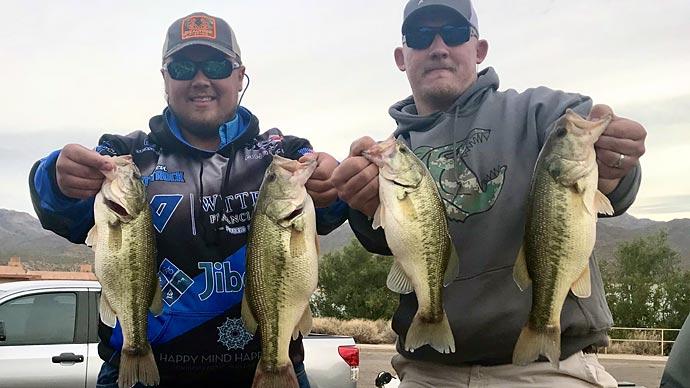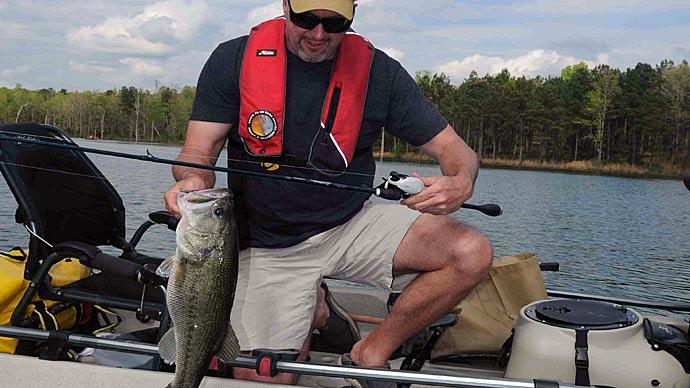
I remember the day, a clear, crisp fall afternoon in October, 1986. One of the defining moments in my career hit me right in the ear, in the form of a telephone call from one of my early mentors in the fisheries business.
"Shocked a lake today," he said, "the second-year bass weighed six pounds."
His excitement was punctuated by the sound of shirt buttons popping on his swollen chest. He had electro-fished one of his new client's lakes, to sample the fish population, to look at forage fish ratios, growth rates of bass, to see the current status of this newly stocked, immature lake. A 6-pound, 2-year-old bass?
As proud as the guy was of the growth-rate, it bothered the heck out of me. Momentary feelings of envy gave way to a voice of reason. Six pounds, in just two years?
It didn't make much sense. After all, depending on the length of the growing season in your geographic region, a 2-year-old bass will weigh 3-4 pounds, even in the best lake. Then I really began to think it through. My concern grew even deeper. Red flags shot straight up my flag pole.
I was troubled, not for the fish, but for the long-term productivity of the lake and its owner. You'd think a 6- pound, 2-year-old bass would be the envy of every lake owner and biologist in the world. But was it really?
After all, Mother Nature seldom, if ever, gives us anything without demanding something in return. No free lunches. I started asking questions.
How many fathead minnows did you stock in the beginning? When did you stock them?
How many bluegill? When?
How long did you wait to stock the bass? How many per acre? How big is the lake?
What kind of cover is there? What's the water chemistry?
The more questions I asked, the more reluctantly the answers came. It was like pulling teeth from a rooster. It didn't take long for me to see that the growth-rates were tied more to personal vanity than to professional wisdom.
Here's what happened: During the first and second years, newly stocked bass over-ate the food chain and grew like Arnold Schwarzenegger on steroids. But, they ran out of steroids in the second year. Bass outgrew the food chain, and ate the lake out of house and home.
During the third year, this crystal clear, unfertile lake developed thick mats of underwater aquatic plants, and the fishery had a big spawn of bass. Lots of baby bass grew into lots of intermediate size bass. Those intermediate size bass fed the larger bass quite well. But, here's the catch. Those giant, originally stocked bass were so few in number that their growth rates were phenomenal - for the first three years. But, survival rates, for whatever reason, were low from the beginning.
Essentially, few bass in the beginning led to fantastic growth-rates early. But, because there weren't enough bass to control subsequent offspring, the lake quickly turned into a stunted bass fishery. A few heroes, lots of 10-12 inch bass quickly running out of food.
So, by the third year, this lake was seriously out of balance and the lake owner was scurrying to fix it. He had not fertilized, never offered a morsel of food for his young forage fish. But, he had a handful of giant largemouth bass.
It was like looking at a gorgeous smile that had missing teeth.
Ideally, when a bass lake is properly stocked, it shouldn't need much tweaking until the fourth or fifth year, as juvenile bass naturally reach overcrowding. And, if the fishery manager is doing his job, selective harvest can be gradually implemented long before intermediate size bass begin to stunt. A balanced fishery is just what the term suggests, a pond with fish populations that can remain in harmony, or close to it. Sizes of fish are balanced, species composition is balanced. Different size ranges of different species, with each species gaining weight, is considered "balanced."
For years, biologists have recommended similar stocking rates for largemouth bass lakes. In new lakes and ponds stock 3-5 pounds of fathead minnows with 500-1,000 bluegill per surface acre. Then, follow with 50-100 largemouth bass fingerlings per acre, based on your goals.
Here's a different scenario, different consequences: One mid-south lake owner built a 30-acre reservoir, hoping for a balanced bass fishery, with a legitimate opportunity to catch a double-digit fish. Modest goals, certainly attainable.
He stocked fathead minnows with bluegill and redear sunfish, gave them, a six month head start. Then, he stocked largemouth bass, some Florida strain fish, some natives, and some genetic mixes, at 50 per acre.
At the beginning, he set up three feeding stations, to expedite growth rates of bluegill, to get them spawning more quickly, setting the table for his impending stocking of voracious bass. Bluegill grew rapidly.
Once stocked, so did the bass. Here's the rub: At the end of the second year, frequency of bass catches was low. The landowner was concerned. His bass were growing well, some of them nearing three pounds. But, he couldn't catch them as easily as he thought he should.
He's an impatient guy. We electro-fished his lake, caught a few bass, all like green footballs with giant mouths. A few bass were surrounded by thousands of forage fish, bluegill ranging from 1-7 inches. All seemed well, until the third year.
Thousands of 5-9 inch bluegill crowded around each feeder, all day, whether there was feed in the water or not. The lake was fertile, and teemed with baby bluegill. Midway through the third year, circumstances suggested bass weren't spawning. An electro- fishing survey proved the theory.
The earnest lake manager faithfully fed his bluegill. Bluegill responded by growing ... and growing ... reproducing and growing more. Bluegill became the dominant species. As their sizes and numbers increased, the demand for bluegill food expanded throughout the lake.
In this case, bluegill were dominating bass nests, before bass could have their first spawn. So, the originally stocked bass were rapidly growing, some near five pounds in their third year, but there wasn't a year class coming in behind the originally stocked fish. Bluegill had turned the tables on baby bass. Or, maybe bluegill set the table by eating baby bass.
To meet his goals, this landowner had to tweak his take early on. He stocked 175 bass from 10-12 inches long, and added 500 fingerling bass larger than 3 inches.
In the fourth year, he was catching bass weighing 8 pounds and better, with young bass climbing life's ladder below. He had bass from 5-8 pounds from original stockings, plus bass in the 2-3 pound class from prior years introduction of intermediate size bass. The fingerling bass moved into the 10-12 inch slot, and fry from natural hatches were seen lurking in the shallows the next spring.
Bluegill numbers dropped, but individual sizes pushed higher. The biggest bluegill he has caught to date topped the scales at 1.25 pounds. Not bad for a four year old panfish.
The moral of these stories? Fisheries management is like a puzzle. You have the pieces in hand. But, putting them together can be tedious. If the first guy had fertilized his lake and kept predator bass away from his burgeoning bluegill population, and kept whatever critters that lurked to eat juvenile bass, he wouldn't have had a 6-pound bass in the second year. And, he wouldn't have had to urgently harvest hundreds of young bass in the third, fourth and fifth years, either.
In the second case, too many bluegill were fed too quickly, for ultimately understocked bass numbers. And, the lake remained fertile through all but the coolest months of the year. Even though this fishery proved easy to fix, if the landowner hadn't been aware of its status, his fishery could have been in trouble during its third year, too.
Fisheries science is as much art as science, maybe more. Maybe lots more art than science. But, if you understand the science, the art can be fun. All the more reason to pay attention to what your fish are telling you.
Gotta go. Phone's ringing. This could be another one of those defining moments.
Veteran fisheries biologist Bob Lusk runs Texoma Hatchery pond consulting service. He may be reached at 903-564-5372. His new book, "Raising Trophy Bass," may be purchased by calling 800-687-6075.
Reprinted with permission from Pond Boss Magazine



